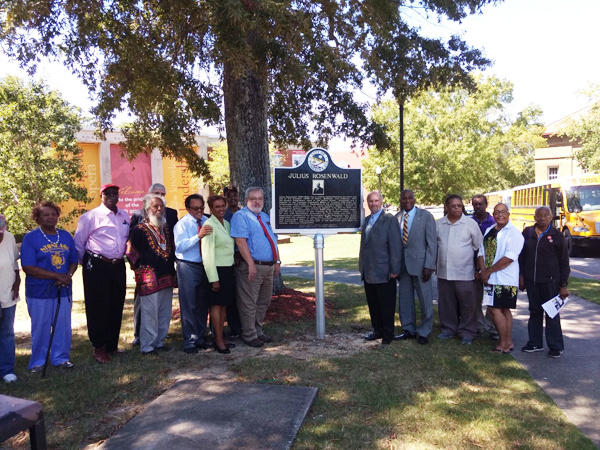
By Judith Rice

TUSKEGEE, Alabama — Friday, September 20, 2019, in the Tuskegee City Municipal Center, the 13-marker Tuskegee Civil Rights and Historic Trail was dedicated. The Trail was the ten-year dream of Tuskegee University History professor and Archivist Dana Chandler. The Trail will be included in the U.S. Park Service’s Civil Rights trails. The Trail came to be because of a biracial, multi-religious partnership in Tuskegee, Alabama.
It had been a long-frustrated dream because Dr. Chandler was unable to find funding to create the system. Grant monies did not come through. State and local funding did not happen. Private funding seemed impossible, until, with indomitable persistence he spoke with the President of the Jewish American Society for Historic Preservation, Jerry Klinger, about his idea. Tuskegee was not a backwater of the Civil Rights movement, it was centrally important to the entire struggle but had been overshadowed by dramatic places like Selma and Montgomery, Alabama. The media, when they speak of Tuskegee, mention the Tuskegee Airman and one of the most important, vital, Black universities in the country, Tuskegee University.
Few knew, few wrote about, and few acknowledged the centrality of Tuskegee and how, almost alone, they changed the Jim Crow South, legally broke the barriers to integrated schooling and made the central premise of American democracy, the right of all citizens to vote and have their vote count, a cornerstone for all America.
Jerry Klinger had traveled to Tuskegee to meet with officials of Tuskegee University about placing a historical marker honoring Julius Rosenwald. Rosenwald had been a close friend of Tuskegee founder Booker T. Washington. Washington, a former slave, and Rosenwald a Jew, knew little of each other’s culture and struggle. But together they grew. They learned. They united in common effort to improve the educational opportunities for millions of Black Americans in a South intent on keeping its former slaves poorly educated, tied to the land, subjugated by ignorance and societal terrorism. Rosenwald, a part owner and leader of Sears Roebuck and Company, used his vast fortune, with Washington’s guidance, to build over 5,000 schools for Black children in the 14 states of the South. He became a major funder and supporter of Tuskegee University.
Rosenwald’s motivation was his Jewish heritage. Rosenwald recognized even in America there was anti-Semitism. But he also recognized that the difference between his experience and the type of oppression that Black Americans experienced was because of skin color. American racism had a greater disdain for Black Americans than it did for Jewish Americans.
Rosenwald wrote, “The horrors that are due to race prejudice come home to the Jew more forcefully than to others of the white race, on account of the centuries of persecution which they have suffered and still suffer.”
May 1912, in an undelivered speech, Rosenwald had prepared a more direct reason for his involvement with the Black American cause:
“But, I take it, if the Jew fails in the discharge of his civic duty, (if) he does not demonstrate to the nation that it acted wisely when it gave the Jew shelter and liberty and freedom. The Jew must be a pillar of civic well-being and moral capacity. He must be the one who in every crisis will be right, militant for the right, the ethical, the spiritual, the best in national life. If he falls short of this standard, he will himself have brought into being the monster which will one day destroy him and unseat him from the position of safety in America.”
Dana Chandler had approached many with his vision for the Tuskegee Civil Rights trail. When he button-holed Jerry Klinger, the response he got for funding and technical support was immediate. The answer was direct and immediate, yes.
Chandler did not know the deep reasons for Klinger’s help.
During the dedication ceremony, Klinger spoke where the willingness to help the Tuskegee community came from.
“My reasons for helping Tuskegee to tell, preserve and educate the Civil Rights struggle of its past that shapes it present and future, began April 11, 1945 in Germany.”
“My father had been a Jewish prisoner in the infamous Nazi Concentration Camp of Buchenwald. April 11, 1945 he was liberated by U.S. Armed forces, the Third Army under George Patton. He was barely alive. He weighed barely 89 pounds. When given the option of where to go after liberation, the answer was focused. He arrived in America in 1947 and saw another reality, the reality, American racism and Black American victimhood. From the time I was very little he taught me and anyone who would listen, ‘Silence, when your neighbor is oppressed, will mean silence when you are oppressed.’ I had come to Tuskegee University to see about a marker for Julius Rosenwald on the campus grounds. When Dana approached me to help, there was no debate. The answer was yes.”
The creation, fabrication and siting of the marker system took nearly a year to complete.
The thirteen markers in the system are for people and events largely unremembered by the beneficiaries of the struggle today. The markers are visible, physical, permanent, interpretive history. They are internet accessible –
https://www.hmdb.org/results.asp?SearchFor=tuskegee+civil+rights
- Trade with your Friends – the Tuskegee Boycott
- Area Churches that Hosted Important Civil Rights Meetings
- Mount Olive Missionary Baptist Church
- Rosa Parks
- Samuel “Sammy” Leamon Younge Jr.
- Tuskegee High School
- William P. Mitchell
- Amelia Boynton Robinson
- Charles Goode Gomillion
- Jesse Parkhurst Guzmon
- Julius Rosenwald
- Tuskegee Institute Advancement League
- Tuskegee Civic Association
After the dedication at the Municipal Center, a bus tour of the markers was conducted. A man with tears in his eyes came up to Klinger. He said his father had been one of the liberators of Buchenwald. His father had told his son how the prisoners crawled up to the barbed wire fence with their last strength to see the liberators and then died, free at last.
*
Judith Rice is the secretary-treasurer of the Jewish American Society for Historic Preservation.
My husband Harvey and I attended the 13-Marker Dedication and went on the tour. This was a historical and inspiring event. I extend thanks and appreciation to the JASHP for your outstanding services that promote human rights.
I appreciate that I can learn about non blacks who participated & contributed to the the Civil Rights History of Tuskegee.
Thank you.
And to those who sought to preserve this history & make it accessible , I say Tjank You & Congratulations ! Job well done!
Judy That was great Nurse Debbie